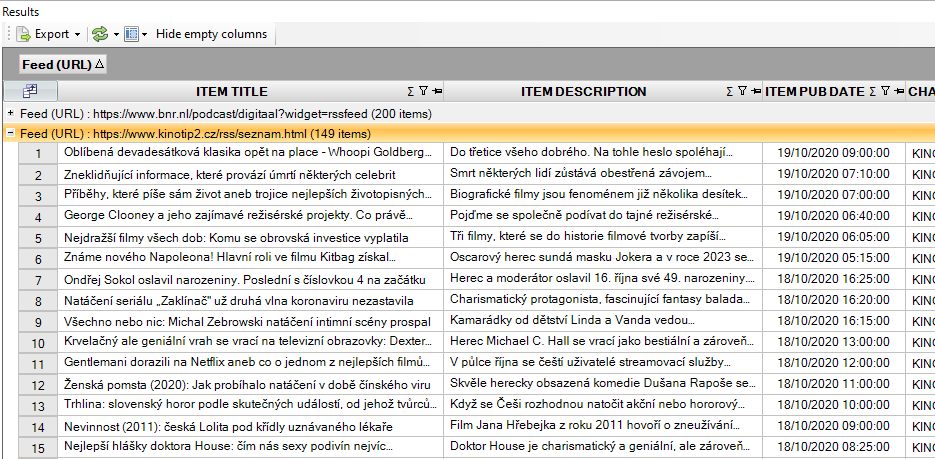The easiest way to handle this scenario is probably to first define a table with the URLs of the RSS feeds. You can define a data container on MySQL using settings*.xml, but for simplicity I will create a table in-memory:
create or replace table xmlfeeds@inmemorystorage
as
select 'https://www.kinotip2.cz/rss/seznam.html' url
union all
select 'https://www.nu.nl/rss/Algemeen' url
union all
select 'https://www.bnr.nl/podcast/digitaal?widget=rssfeed'
In the next step, you can retrieve all the RSS-feeds using httpdownload and then parse the XML contents using xmltable as shown below:
create or replace table entries2load@inmemorystorage
as
select xfd.url
label 'Feed (URL)'
, ety.item_title
, ety.item_description
, ety.item_pub_date
, ety.channel_title
from XMLFEEDS@InMemoryStorage xfd
join HTTPDOWNLOAD@DataDictionary(xfd.url) htp
join xmltable
( '/rss/channel/item'
passing htp.content_clob
columns item_link varchar2 path 'link'
, item_guid varchar2 path 'guid'
, item_guid_is_perma_link bool path 'guid/@isPermaLink'
, item_title varchar2 path 'title'
, item_pub_date datetime path 'pubDate'
, item_description varchar2 path 'description'
, item_category varchar2 path 'category'
, channel_title varchar2 path '../title'
, channel_link varchar2 path '../link'
, channel_description varchar2 path '../description'
, channel_language varchar2 path '../language'
, channel_web_master varchar2 path '../webMaster'
, channel_copyright varchar2 path '../copyright'
, channel_last_build_date date path '../lastBuildDate'
)
ety
The results will resemble:
The final step is to bulk load the data into your MySQL database. When there is yet no existing table, you might want to use create or replace table NAME@mysql instead of bulk insert. Code to load the RSS entries from all sources into MySQL table:
bulk insert into NAME@mysql
( item_link
, ...
)
select item_link
, ...
from entries2load@inmemorystorage
For incremental loading you might want to consider the use of the synchronize statement which you can configure to only update existing rows and insert new rows. Another forum topic describes the synchronization between two database tables across data containers. More details on synchronize are in the Invantive SQL grammar and some other samples: concept and sample Visma.net.
